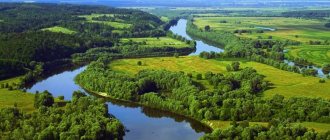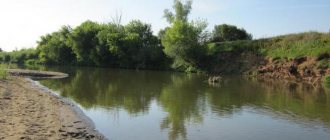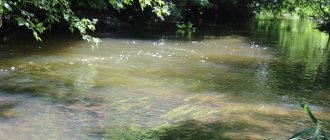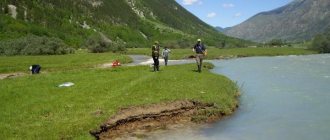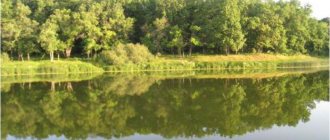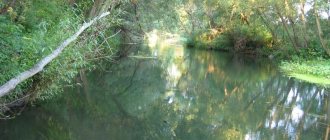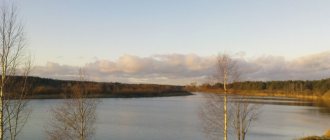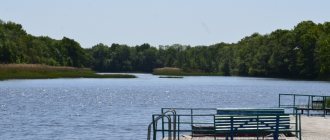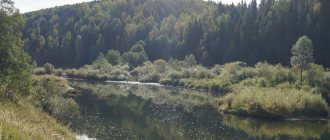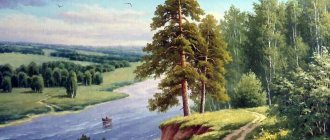Interesting Facts
The Desna is one of the most capricious rivers in Russia. Already in early November it can be covered with ice, which limits fishermen in their activities. In April, the river gradually overflows its banks, flooding coastal lakes, meadows and fields. After this, in the nearest reservoirs you can find plenty of fish that are found in the Desna.
In the coastal thickets you can find a huge number of birds that build nests here. The waters of the Desna are highly valued for containing a large amount of iodine, which is readily absorbed by the medicinal plants that grow above the shore.
This deep river has a length of more than 1,130 kilometers. It attracts tourists and fishing enthusiasts with its picturesque shores, clean water and fresh air. Most of all, fishermen fell in love with Desna for its huge variety of fish. Here you can meet about 30 species of river inhabitants, which can be caught at any time of the year. Both sport and amateur fishing have gained popularity on the Desna.
Who to catch?
There are a lot of fish in the Desna: from species listed in the Red Book to the most common inhabitants - roach, crucian carp, and so on.
Here you will meet:
- perch;
- pike perch;
- loach;
- soma;
- carp;
- bream;
- silver bream;
- crucian carp;
- ide;
- pike;
- asp;
- tench;
- roach and many other species.
A wide variety of baits and tackles are used for fishing - it all depends on the type of fish that the fisherman wants to catch. An ordinary float rod is good for catching ide, ruffe, perch, roach and bream, especially if maggot or worm is used as bait.
What remarkable things can you see along the river?
There are many ancient cities of Ukraine on the Desna River. For example, the already mentioned Novgorod-Seversky is a city of the Drevlyans, founded in 989. It is located in the Chernigov region.
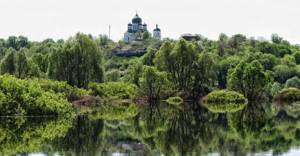
The city is of great historical value: many events related to Kievan Rus took place there, and even in earlier times. There are also many interesting cultural and historical monuments there. But, unfortunately, over the years Novgorod-Seversky is becoming less and less in terms of population. The economy and industry in the city are not developing, even a powerful tourist base is simply idle unnecessarily, and young people prefer to leave for larger cities, where there are at least some prospects.
Bryansk fishing on the Desna
The length of the river in this region is about 500 kilometers. Here you can find about 20 varieties of fish. Therefore, it is not at all surprising that fishing on the Desna in the Bryansk region is so popular. The most common river inhabitants are burbot, asp, ide, carp, roach, carp, pike perch, and bream.
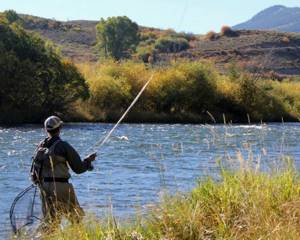
For many local residents, catching pike perch is a favorite pastime. “Fanged” is usually caught with a wobbler, since it bites rather weakly on regular bait. To choose the right size bait, you should experiment a little on the river or ask for advice from experienced fishermen who know the habits of the predator well.
Some fishermen prefer to use paid fishing services. There are many coastal lakes in the region, which are rich not only in fish stocks, but also in picturesque places. Also in the Bryansk region you can find many artificial reservoirs that are constantly stocked with fish. In most cases, paid fishing on the Desna involves catching salmon, carp or trout, which are bred here by local farms.
Fish biting forecast on the Desna
| Weather forecast and fish bite | Calendar, from 02/16/2021 to 02/19/2021 | |||||||||||
| VT | SR | Thu | PT | |||||||||
| Times of Day | Evening | Night | Morning | Day | Evening | Night | Morning | Day | Evening | Night | Morning | Day |
| Cloudiness, precipitation | Partly cloudy | Partly cloudy | Mainly cloudy | light snow | light snow | light snow | Partly cloudy | Partly cloudy | Mainly cloudy | Partly cloudy | Clear | Partly cloudy |
| Temperature °C | -16 | -16 | -15 | -13 | -8 | -12 | -19 | -19 | -11 | -19 | -22 | -22 |
| Pressure, mm. | 771 | 768 | 765 | 763 | 762 | 762 | 762 | 763 | 766 | 771 | 773 | 774 |
| Direction, | West wind | Wind southwest | Wind southwest | Wind southwest | Wind southwest | West wind | North wind | North wind | North wind | North wind | North wind | West wind |
| wind speed | 3 m/s | 4 m/s | 5 m/s | 4 m/s | 4 m/s | 2 m/s | 2 m/s | 3 m/s | 4 m/s | 3 m/s | 2 m/s | 1 m/s |
| According to the forecast, they will bite on: bloodworms crucian carp | 50% | 0% | 55% | 55% | 45% | 0% | 45% | 45% | 30% | 0% | 45% | 60% |
| According to the forecast, the fish will bite on: live bait (jigs), winter spinners, balancers Pike | 50% | 10% | 75% | 75% | 65% | 25% | 45% | 45% | 50% | 0% | 45% | 60% |
| According to the forecast, they will bite on: bloodworms, winter spoons, balance beams Perch | 60% | 0% | 65% | 65% | 55% | 0% | 55% | 55% | 40% | 0% | 55% | 70% |
| According to the forecast, they will bite on: bloodworms, maggots, bark beetles, burdocks Chub | 50% | 30% | 60% | 45% | 40% | 20% | 50% | 35% | 20% | 10% | 50% | 55% |
| Bait: maggot, bloodworm Bream | 50% | 65% | 50% | 40% | 40% | 55% | 40% | 30% | 20% | 45% | 40% | 50% |
| Bait: maggot, bloodworm Roach | 50% | 0% | 75% | 65% | 55% | 0% | 55% | 45% | 40% | 0% | 55% | 60% |
| Bait: maggot, bloodworm Bleak | 50% | 0% | 50% | 50% | 40% | 0% | 50% | 50% | 30% | 0% | 50% | 60% |
A more accurate bite forecast for each region of Ukraine and Russia through which this river flows:
Sumy region BITE FORECAST
Chernihiv region BITE FORECAST
Kyiv and Kyiv region BITE FORECAST
Smolensk and Smolensk region - FISH BITTING FORECAST
Bryansk and Bryansk region - FISH BITTING FORECAST
The bite forecast for this river is taken approximately in the middle reaches, so it is better to look at each area separately. This way it will be more accurate.
Moscow region
In early September, pike and perch are actively biting here. It is at this time of year that the fishing season opens on the Desna in the Moscow region. Predators can be found mainly near the algae in which they spawn. If you have chosen a deep place, then you can hunt right off the shore, but if not, it is better to use a boat. Also, fishing on the Desna River in the Moscow region involves catching roach and bream, which are found here in large quantities. In the autumn season, they begin to actively fatten up, preparing for the winter, so you should not have problems with biting.
For better results, professional fishermen recommend using special bait. Such actions will help you catch several types of fish at once in one place. Perch, roach, bream, asp, and so on can bite on the same bait. If you want to catch one of these types of fish, we recommend using a worm, dough, bread or bloodworm to bait your hook.
You can catch a nosefish, ruffe or roach with a regular float rod. At night, donks perform well, with the help of which you can easily pull out burbot or perch.
On the gum to visit Dunno
I know a place where even in November you can catch great fish both with a float rod and with a spinning rod. Along the yellow line we take the metro to Teply Stan, transfer to a regular bus that follows the old Kaluga Highway to one of the wonderful corners of the nearest Moscow region, we get to the “Sovkhoz” stop or to “Voskresenskoye”, and there it’s a stone’s throw to the fishing spots. A twenty-minute leisurely walk will lead you to one of the wonderful rivers near Moscow - the Desna. This river is not wide - you can throw a stone almost anywhere. The distance to the opposite bank is only 30 m. Despite its small size, the Desna River is not a simple river. The topography of the river bottom is very diverse: fast riffles suddenly give way to whirlpools, where perch and roach lurk under old flooded logs. There are also heavily silted areas, where the current is slow and viscous, like jelly. In such places, beautiful silver crucian carp are sometimes caught very well. The abundance of elegant cottages that have grown up in the last decade along the banks of the Desna River may disappoint the fastidious fisherman. What can you do! But it is convenient to get there. But if you walk along the river, you can easily find undeveloped areas where you can safely fish.
Desna was very lucky with the remoteness of industrial zones. In its clean and clear water, bleak, roach, bream, chub, and roach are well caught until late autumn. And of course perch and pike. It happens that you come across ides and podusts, but the latter are very rare. And sometimes an asp sits on the tee of a small “turntable”.
A person who comes here for the first time may be alarmed, or even scared away, by the large number of hooks. For this reason, many try to fish in clean areas of the river. But on the Desna, all the fish concentrate mainly under fallen trees, under bushes, behind the bends of the river. Fishing on the Desna also requires constant experimentation with baits. Pay close attention to the slightest changes in the current. This will allow you to accurately determine the locations of depth differences. There's fish there too. In such places in the fall, although not for long, a float rod will still work. And with a spinning rod we will go to the dam, near which the depths (on the riverbed) reach three meters - this is the maximum depth for such a river. Record-breaking, one-kilogram perches live here.
The Desna has a small tributary. It's called Dunno. It flows just opposite the village of Penino. The channel is narrow, but quite deep - up to 2 m. Seasoned pike like to visit here. Spinning anglers often catch here “tails” weighing 3 kg, or even larger. It should be noted that somewhere from the end of May, the coastal zones of the Desna and its tributary Neznaika begin to be actively overgrown with underwater grasses. But by October the grass subsides. This is where the holiday begins for those who like to go fishing with a spinning rod. The predator should be looked for near snags and any other underwater heights, be it lonely stones or an entire flooded island. And when, after prolonged rains, the water in the river rises and fills the small coastal bays, pike will rush here after the fry that have washed ashore. On such days you can observe her intense “fight”. Don't yawn here - catch the splash.
I am not a fan of wobbler fishing; I prefer to fish with traditional spoons. But, using oscillating and rotating spoons, already in June you are faced with the problem of guiding them among overgrown vegetation.
This is where a wobbler can help out. Last dry summer, during the flowering period of underwater thickets, I caught pike in the Desna using a floating wobbler, and sometimes successfully. But in the fall, of course, I give preference to a darkish, bronze-colored “shaker.” Success most often comes from slow retrieves with long casts and lifting the spoon off the bottom. A live bait fishing rod still gives good results.
It is difficult to say where there is more fish, in the Desna itself in the Moscow region or in its tributary. The distance from the dam to the Desna itself is less than 1 km. Below the Dunznayka dam it becomes very shallow, and the channel here is narrow. The bottom is sometimes silted, sometimes rocky and pebbly. The depths in this area, right up to the confluence of the Dunno and the Desna, rarely exceed 1 m in the fall, and the current noticeably intensifies. In terms of the species composition of fish and the number of “tails” caught here daily by fishermen, the tributary noticeably outperforms the river. So it’s not too late to take a spinning rod to the Desna to visit Dunno.
Smolensk region
Fishing is carried out mainly during daylight hours on the Desna River in the Smolensk region. Fishermen noticed that during the day a large amount of high water, asp, ide and roach accumulate near the shores. Larger specimens live at depth. By evening you can catch pike perch, gudgeon or ruffe here. These types of fish appear off the coast due to changes in temperature; accordingly, in the evening the food supply moves.
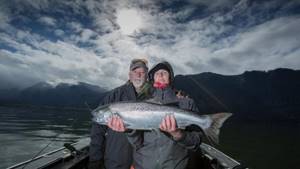
In the Smolensk region you can also catch a respectable size catfish. For this purpose it is best to use a bottom rod. A bunch of crawlers, a mole cricket, a pearl barley or a frog are suitable as bait.
But pike perch, pike, ide and asp bite well on a spinning rod. In this case, you can use a variety of baits: spinners, silicone, wobblers, and so on. However, as experienced fishermen say, it is not enough to know how to fish, you need to know good places. But this may be a problem. The fact is that most of the fishing spots here have already been captured. Therefore, paid fishing has become widespread here.
Description
The Desna is formed by the confluence of the Pakhorka and Butyn rivers near the village of Kalininets. It flows into the Pakhra near the village of Dubrovitsy, near Podolsk[4].
The length is 88 km, the drainage basin area is 717 km²[5]. The main nutrition of the Desna, like most Moscow rivers, comes from melted snow waters: they make up about 60% of the total total flow, the share of rainwater ranges from 12 to 20%. The rest comes from underground springs[6].
The tributaries of the Desna are the Sosenka and Neznaika rivers[7][8].
On the banks of the Desna are the village of Alabino, the cities of Aprelevka and Troitsk[9].
Fishing in Trubchevsk
There is not as much fish here as in other regions, but fishing in Trubchevsk on the Desna is a real paradise. The banks here are well washed with water, which allows you to get comfortable for fishing. Nearby you can find a large number of meadows, oxbow lakes and spits, along the edges of which there are tall trees. The landscape of unique beauty attracts fishermen from all over Russia.
At first glance, catching fish from the shore will not be difficult, but this is a deep misconception. Quite often, fishermen return home without a catch. This happens due to incorrectly selected gear or bait. It is also recommended to use bait for a particular individual to attract a school of fish.
A good bite is expected with the arrival of spring, when the Desna has already overflowed. For this type of fishing, a spinning rod is best, especially if you want to catch large fish. In pools or on spits you can find asp in large quantities. To catch it, it is best to use wobblers or spinners.
Some fishermen prefer to hunt pike. It is best to look for adults in areas with calm water. Most artificial species are suitable as bait. You may also catch some big bass in early summer. In most cases, it will bite in the same places as the pike.
Desna fishing
The Desna River is a left-bank tributary of the Dnieper, with a length of about 1130 km. The river valley consists of sandy and clayey rocks with an admixture of chalk. In the floodplain, which is very swampy, there are a large number of lakes. The river bed is constantly changing, the water speed is high. There are a variety of fishing conditions and a fairly wide range of species.
The permanent inhabitants of the Desna are catfish and pike, pike perch and asp, crucian carp, loach, ruffe, tench, burbot and perch, bleak and dace, rudd, silver bream, roach, carp and ide, chub, podust, barbel and others. Sometimes you can see a beluga with a sterlet.
Winter fishing on the described river is gaining momentum every year. Beginners should not forget that in January fishing on this river is quite difficult. This is explained by the fact that oxygen in the water is becoming less and less, and schools of fish are moving to the entrances of oxbow lakes and to the mouths of the Desna tributaries. The winter season for local fishermen begins in December. From this time on, the ice on the river becomes very thick, about 14 cm, and fishing begins in the river bed.
In the first ice they lure perch and pike, and tie a bright woolen thread or bloodworm to the hooks. Good roach, bream, and silver bream are well caught using float rods. The bait in this case is the same bloodworms, steamed wheat, etc. Small pellets with bloodworms for fish living in the Desna (mainly lake fish species) are considered the best bait.
From mid-January, perch can be caught well with small spinners. You can catch pike with a girder.
Roach and silver bream (lakes) bite well on a float rod with a jig. Since the bites of this fish are very weak, the fishing line is chosen very thin, and the float is changed to a sensitive nod.
It is preferable to fish with bait (bran, flour, breadcrumbs). If you are catching perch using a spoon, then bloodworms are best suited as bait, and the movement of the spoons should be as smooth as possible. The nosari ruff that lives in the river is considered the best fish for making fish soup.
Also interesting: Lake Pleshcheyevo fishing
With the help of bottom gear and rolling (the best method for fishing in strong currents, when the equipment rolls along the bottom), burbot fishes well at night. Worms and small ruffs are used as bait. In river holes, professionals successfully pull out pike perch using spoons. Using jigs in a deep place near the mouth of tributaries, large specimens of roach, blue bream, and bream work well (not very well).
Starting from February, the number of fish in the river increases, and March can generally be considered a “fruitful” month.
Due to the gradual warming of the water by the March sun, normalization of the oxygen regime is observed in the Desna. Different breeds of fish are returning to the river, and there are more and more fishermen on the river.
Sinks, bream, and ruffs are excellent for catching, and the most suitable gear is float rods with animal baits made of bloodworms and red worms.
The March feast of pike, preceding spawning, reaches its peak of activity, and fishermen successfully pull out this large predator using live bait lowered to the bottom and baited by the lips, as well as on the ramp and under the ice. There are frequent bites of large burbot, perch and pike perch. In the upper layer of water near the melted shores, perch and sometimes large pike actively begin to bite on spoons. The predator spawns in the floodplain areas of the Desna from approximately March 15 until the last days of April: first, young pike go to spawn, and at the end - large, mature, cunning and vindictive.
In April they catch mainly with summer float rods. The so-called meadow streams become a refuge for rudd and perch, large sabrefish - in places where there are whirlpools. It is preferable to catch sabrefish using a large worm using a white winter spoon (it is better not to use a float); the hook should be done after a noticeable nod of the rod tip. When mass spawning of fish begins, its catch is limited or completely prohibited.
In May, fishing for sabrefish is the most interesting; burbot, ide, pike, pike perch and chub are also good.
Also interesting: Ob fishing
With the help of summer gear, burbot become active from the end of April to the end of May. The best time to catch this fish is night. When the water in the Desna becomes very warm, burbots go into deep holes where the water is still cold. Yazi bite well on May beetles; the tackle is a fishing rod made of 3-meter-long hazel.
The most active ide bite occurs in the morning and evening hours. You can also pull out a chub with an ide. Pike-perch are caught mainly using bottom baits at dawn and in the late evening hours. The bait is a gum minnow, or goby, a small brush and a spike.
The lower and middle reaches of the river can delight anglers with catching large pikes, the spawning of which has been delayed. The gear is the same as for catching pike perch, and the best bait for a predator is a small brush. Quite large lake pike have been caught in the flood lakes since mid-May. The tackle is a rotating spoon.
Summer fishing on the Desna is especially popular. Fishermen hunt for pike, perch, ide, and asp.
Catfish activity increases in the last days of June. Fishing is carried out with all types of fishing and using various gear. But on the hottest days, the fish becomes very lethargic, its appetite decreases, and fishermen acquire the status of vacationers.
In autumn, Desnyansk fishing is famous for its high catches, but the activity of pikes (the first days of September) decreases slightly. With the onset of October, larger pike begin to bite, and they hide mainly in snags. The predator is best caught on a jig head. Of course, snags often occur. But catching the trophy will be your reward. In September-October, pike perch delights with its unbridled appetite. As the river level rises, predators begin to behave very carefully, and bites become weaker.
November is a slow month for fishing: everyone is waiting for the season to start. Beauty Desna gives everyone, without exception, an excellent active holiday, and anglers - interesting fishing and excellent catches.
Author N.K
Category: Fishing spots
Fishing for bream
Fishing on the Desna is quite a difficult task, but if you take into account the recommendations of professional fishermen, you will certainly return home with a big catch.
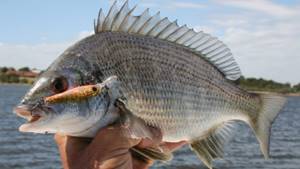
The process of catching bream on the Desna River itself is nothing special, although it is recommended to follow the tips given in the article. First of all, you will need to choose a suitable place for fishing. It should be relatively deep - at least three meters, so it is recommended to use an inflatable boat. The bottom should be muddy, since this is where the bream settles. You can give preference to deep holes that are located near capes.
Remember that bream is a rather cautious fish. She can be frightened by any suspicious smell or too loud sound. You should start hunting early in the morning, since it is at this time of day that she swims out to feed.
Secrets of a big catch
There are several well-known ways to increase the intensity of the bite. They all work well on Desna. We present to your attention the most effective of them:
- Bite activators are special devices that can attract fish in warm and cold water using pheromones. These substances stimulate the fish’s appetite, which significantly increases the frequency of biting. True, Rosprirodnadzor is trying to introduce a ban on the sale of such activators.
- More sensitive gear - reels, fishing lines, hooks, and so on. They practically do not increase the intensity of the bite, but they reduce the chance that the fish will fall off the fishing rod as a result of hooking.
- Various food baits using pheromones. They attract a flock of slaves from a fairly large distance. As a rule, this is a favorite delicacy of aquatic inhabitants mixed with oils.
Remember that as soon as the bream gets hooked, it will begin to actively resist, so you need to be able to pull it out in the shortest possible time. It is also recommended to use good feeder tackle.
Desna River
05/31/2013 N 55.29.745 – E 37.27.111
Desna means “right” in Old Slavic. This is probably why we have quite a lot of rivers with this name (I counted seven), and all of them are left tributaries of other rivers. Why not the right ones? Because in our time we associate the concept of “left” and “right” tributary (or bank) with movement from source to mouth, but with our ancestors it was the other way around.
The Desna, which flows in the Moscow region and is a left tributary of the Pakhra River, is a fairly large river. Its length is 91 km. After studying the map, I decided to go to the area of the villages of Evseevo and Kuvekino, which is not far from the village of Vatutinki.
According to the map, the river in this area flows slightly away from large populated areas, and satellite images show a road leading to the shore. The river itself makes several turns, and these places should be promising from a fishing point of view. How it really was could only be found out on the ground.
I liked the area immediately. A wide field with beautiful forest around the edges. The river is not wide, with a fairly fast current, there are whirlpools and return paths.
It can be seen that the flood was powerful, but the water level had already dropped significantly and, according to the fisherman I met, the river was almost at its banks. From him I learned that bream are now being caught in the river (he himself catches on the feeder), and sometimes roach is caught.
For about twenty minutes I walked along the high bank and chose a place. Not only is the shore high, but it has not dried up after the water subsided. It was possible, of course, to drive a little further along the river and see the surroundings, but I didn’t want to leave such a nice and promising place.
He who seeks usually finds. So I found it. A small ledge just above the water's edge, formed by a fallen tree. There is enough space to sit. And trees growing on the shore will not interfere with fishing.
There were fish splashing all over the river. I wanted to quickly cast the fishing rod.
The depth at the fishing spot turned out to be a little more than a meter. The return road is not far from the shore. I fed it right where there was almost no current.
But I caught my first fish in a completely different place. The roach sank the float on the second trip, coveting the maggot.
Things went well. Following the roach, a small bream was caught, clearly not reaching the permitted size. Behind him is already quite marketable. And literally in a few minutes it will be ready for sale without a doubt. Only the lack of a landing net and the tree lying along the shore, thanks to which I settled here, did their dirty deed. I was unable to lift such a fish through this same tree on a 0.1 mm leash. I simply couldn’t take her any other way. As a result, an offensive break.
The fish took it as soon as the bait was on the border of the streams. She took it greedily. The roach we came across was different, sometimes quite acceptable. But the bleak was the wrong size. Maybe there is a larger fish in the river, but I didn’t catch it. But I caught a chub, or rather a chub. 200 grams, no more. It was probably he who chased the fry all over the river. According to another local, there are chubs in the river and more than half a kilo. I willingly believe him.
Nightingales sing, cuckoos crow, woodpeckers chirp, fish are caught, the river gurgles - and all this is 20 km from the Moscow Ring Road. If it weren’t for the plastic bottles carried by the current to the rubble of trees, one would think that Moscow was somewhere far, far away. But the river bank, to my surprise, was almost clean.
But another scavenger, about four hundred grams, which again broke my leash, did not surprise me at all, but what surprised me was the ruff, which grabbed the maggot halfway through the water, but refused to take it with the worm when I tried to catch it with a side nod.
No one reacted to the worm at all. And the maggot attached to the jig tempted both roach and bleak to bite. A cat-loving neighbor, with whom I said goodbye when I went fishing, asked me to bring her some fish, which I gladly did.
I had the most positive impressions from visiting Desna, and I had a desire to come here with a spinning rod and “probe” the local snags for the presence of a predator. For some reason I am sure that I will not leave without fish again.
DIRECTIONS
By personal vehicle
Along Kaluga Highway until you turn left to Evseevo and Kuvekino, then follow the main road to Cherepovo. After Cherepovo, turn left along the power line to Evseevo. There, at the fork, go left. Straight ahead and at the other fork turn right until you reach the “Private Territory” sign. In front of it, go right into the field - and along the forest to the river. After many days of rain, the road is not passable for all cars.
By public transport
From Kursky Station by train to Podolsk, then bus 1045 to the Prometheus Gardens stop. Despite the proximity to Moscow, traveling by public transport is quite difficult. The nearest stop is on the opposite bank of the river.
We are on Google+ Fisherman-Fisherman
a point on the map
| Author | Konstantin Alekseev, Moscow |
| Issue number | 22/2013 |
| Read the article | 6915 |
Rating: 3.25
Catching catfish on the Desna
The best time to catch catfish is late summer. At this time of year, the fish are actively looking for food, so you can expect a good bite. However, a good catch will come only to the fisherman who chooses the right place and uses good gear and suitable bait.
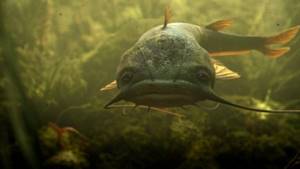
It is best to catch catfish using a powerful spinning rod that can support fish weighing at least 20 kilograms. It is also worth getting a high-quality reel and fishing line. Catfish appear on the surface of the water in the late evening or early morning. For bait, it is best to use large pieces of fish or live bait. Don’t rush to hook; it’s better to give the fish a little time to taste the delicacy. As soon as the catfish swallows the bait, it will hook itself and all you have to do is pull it ashore.
Features of catfishing
There are so many ways, baits and types of catfish fishing for as many fishermen as there are.
On the Desna this fish is caught in three ways:
- "Kwok"
- Bottom gear
- Trolling
“Kwok” is an ancient method of catching catfish. When the “kwok” hits the water, a specific clap is produced, which should be both dull and echoing. Nowadays, quokkas come in metal and wood. Experienced somyatniks make quokkas on their own.
Recently, trolling for catfish has become widespread.
This method is very effective, but you will need a boat with a reliable motor and gear:
- Rod with 100 – 120 grams of dough;
- A powerful reel that can accommodate more than 200 meters of “braid”, 0.3 – 0.35 mm thick. It is very important that it be metal, since any other material may not withstand the fight against large catfish. One of the best is the inertia-free Daiva TS-3500.
Proven spinning reels for catfishing:
- Penn SSM 950
- Penn Liveliner 750
Some people prefer cartoon ones:
- Spro Freeliner LCS575
- Mitchell Avocast FS7000
It is best to use a leash made of soft braided metal cord. This will help protect against the teeth of the catfish, which can grind even durable braid.
- There are two types of fishing with bottom gear : spinning and reeling.
- It is better to take a powerful spinning rod , 2-3 meters long, with a dough of 200-300 grams.
- The reel should have a good drag and a large spool so that a 0.35 mm cord can fit into it.
- It is better to take a thick cord , at least 0.35-0.38 mm thick and 140 cm long, with a load of 40 kg.
- Hooks must be sharp . Gamakatsu or Owner number 12 are perfect.
- SPRO leashes made of Kevlar with a diameter of 1 mm are recommended. Make sure that its length is more than a meter, since the caught fish may be damaged by the braid. You can also lure monofilament, but its diameter must be greater than 1 mm. We described what monofilament is here.
Since the current on the Desna is strong, and the gear must remain in place, it is better to use heavy sinkers weighing more than 200 grams. If you haven’t taken care of them in advance, you can use improvised materials, for example, ordinary stones. To fish with a line, we first need to make it. One day I tried to make this simple device.
For this we need:
- A piece of cord, 20-30 meters;
- Hooks No. 10-12 (5-10 pcs.);
- Weight weighing 200-250 grams;
- Lead line (0.7 - 0.8).
To one end of the cord, I used a nylon one, you need to attach a weight. Next, at a distance of about a meter from this load, I made loops on the fishing line, and already tied leashes with hooks to them. Their length should be approximately 40 cm.
The second end was already secured on the river bank. I caught it with live bait. I bet 6 pieces and received a reward in the form of 3 soms, with a total weight of 4.8 kg.
Troitsk
Fishing is carried out mainly with the help of feeders in Troitsk on the Desna. In most cases, the feeder is used to catch bream. This practice is also used when fishing on the Desna in the Moscow region. There are quite a lot of interesting species of fish in this region, but bream bites best. For a successful event you will need to collect the following gear:
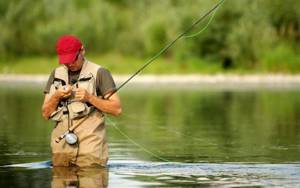
- bite alarm;
- good feeder;
- sharp hooks;
- rocker;
- camel;
- high quality reel;
- fishing line of at least 0.3 millimeters;
- spinning rod that can withstand a weight of at least 10 kilograms.
The casting distance of the feeder depends on the bottom topography. As soon as the feeder with bait is in the water, you need to attach a special alarm to the rod, which will notify the fisherman about the start of the bite.
Reviews about fishing
In any season, you can meet many experienced fishermen on the Desna. You can read a wide variety of reviews about fishing on the Internet, but most of them are positive.
Fishermen write that here you can catch a fairly large pike, but you will have to wait for a catch for several hours. During this time, you will be able to pull out a lot of perches, which, without much effort, “jump” onto the hook. Large specimens are quite difficult to pull out, since they actively resist. Lovers of quiet hunting used worms and maggots as bait.
Other fishermen claim that they have been able to catch many large chubs and roaches using worms in wet weather. Also during this time we caught several perches of various sizes. The picturesque local landscapes are noted.
But some were unhappy with the poor bite in the morning. They had to sit for several hours before they saw any movement of the float.
Pike-perch: fishing seasons on the Desna
We will talk about catching pike perch in not the most comfortable conditions. The Desna is a very fast, deep river, with steep slopes on the bank and sharp underwater drops, long coastal zones are littered with trees washed away by the flood - in general, there seems to be nowhere to fish...
However, where spinning anglers on the Desna have a hard time, these are the favorite habitats of pike perch. On rivers where the current is much slower, for example, on the Dnieper, pike perch can be successfully caught in open places where there are at least some pits and there is no snags at all. On the Desna this is more difficult, and therefore the main baits in the arsenal are various rubber on offset hooks. Colonies of shells in the river are found not only at the bottom, but also on underwater snags, so I see no reason to use thin braided fishing lines. On Desna I use cords with a breaking load of 20 lb. Summer
After the water subsides, pike perch mostly stays in the riverbed holes, and in the morning and evening they often visit the sandy shore shallows to chase fry. Some fishermen are very successful in catching it in the shallows with wobblers, but I prefer jigs in holes with a depth of 5 to 8 m. I use a hinged mount with an offset rig, the weight of the load is usually 18–22 g. In the shallows I fish with loads of the same weight, only doing the wiring with a rod (American style), picking up the slack in the line with a reel. For these purposes I use short (2 and 2.1 m), lightweight and fairly powerful fast action bass series rods. With such spinning rods it is easy to control the wiring and cut through the bony mouth of a pike perch. The success of fishing depends on the correct selection of fishing no less than on the bait. I will highlight a few of the most proven and proven: • 2 short jerks with a spinning rod, after a second another jerk and a smooth pull of the bait along the bottom, then a pause of 3-5 seconds, and again repeat the cycle; • 2–3 tosses of the bait, a pause of 2–3 seconds, again 2–3 tosses, a pause of 2–3 seconds and pulling the load along the bottom by 20–30 cm with a sharp toss at the end and a pause of up to 10 seconds; • sharp toss - pull 10–15 cm, then you can repeat the cycle without a pause or pause for up to 5 seconds. During all jerk wiring, we take up the slack with the reel, not allowing the cord to sag; • and, of course, the classic: 2-3 turns of the coil - pause. Where would we be without her?! It is very difficult to select favorites from baits during this period, since the activity and tastes of pike perch are constantly changing depending on many factors. The most popular in my arsenal: • Action Plastics 3 FG twisters, colors - electric blue, sand, yellow-lime. • Bass Assassin vibrator tails 5 cm long, models Swim Bait, Freshwater Split Tail Shads, Sea Shads - pink, caramel, pearlescent with sparkles. • twisters and vibrating tails from Reins, models Rock Vib Shad, Fat G‑Tail Grub, Bubbling Shad - lilac, acidic, brown.
Autumn
From the end of September to the beginning of December, a meeting with a trophy pike perch is most likely, and in general, autumn fishing is the most interesting.
Hard, clear blows that cannot be confused with anything else. There are much fewer indistinct pokes, the pike perch grabs it greedily, swallows it, and therefore the tackle requires special attention. You will need a fast action spinning rod 2.2–2.4 m long, a 4000 reel, 20–25 lb cord, powerful and sharp offset hooks. The favorite baits are twisters, rippers and various crustaceans 7–8 cm long. The most working colors for twisters are lilac, marsh, dark sand with sparkles, and dark cherry. Rippers are often shot with a red tail, green back and pearl belly. Different shades of cola (from light to dark), plum, dark caramel, and electric blue also work well. I prefer machine oil, dark greens, black, white, sand with greens in colors of crayfish and other crabs. Of the specific models that have proven themselves well: • Keitech - Crazy Flapper, Swing Impact, Easy Shiner. • Lucky John - Hogy Shrimp, Classic Roach, Mr. Greedy. • Bass Assassin - Sea Shads, Swim Bait, Turbo Shads. • Fox Rage - Shad Firetails, Swimmer, Leech. • Action Plastics 5FG. I select offset hooks so that the tip is slightly further than the middle of the bait’s body.
I consider this installation to be universal for all seasons. In the fall, I prefer high-speed retrieving: 2-3 turns with the reel handle and a pause until the tip of the spinning rod is returned, then again 2-3 quick turns.
Pike perch is active, greedy and is always able to catch up and attack potential prey. In autumn, the fish always swallows the bait deeply, and there are practically no escapes. At this time, in my opinion, it is better to overload the bait a little rather than underload the bait. Pike perch like a clear vertical step with the click of the bait on the bottom, and this can be achieved with a heavier load. Having analyzed all the catches of large pike perch on the Desna over the past few years, I would venture to draw the following conclusions: • Large pike perch likes to stand near a boulder, a single snag or a tree trunk, lying at depths of 6 to 8 m (usually at a decent distance from the shore or even on the riverbed ) and located away from the main snag. Not far from such a place there should be an edge, a riffle or a watering hole where the pike perch goes to hunt. • Good points are where, in front of a potential ambush site (for example, in front of a flooded snag), the current is reduced due to pits or mounds. The pike perch here does not make much effort to stay in place, and therefore stands at such points constantly. Having discovered such a point on the Desna, sooner or later you will definitely catch a decent pike perch if you fish for it constantly. The largest pike perch were caught in cloudy, windy weather, often with rain. Fishing, of course, is not very comfortable, but it’s worth it. Spring
In spring, there is no point in fishing on the riverbed, where the current is very powerful and the water is muddy, and normal fishing will not work, since even a 60-gram sinker will be carried uncontrollably by the current.
In the spring, we look for holes with a small return, edges close to the shore, preferably with single snags and a current that allows retrieving with a load whose weight does not exceed 35 g. During this period, I use large baits that are clearly visible in muddy water: • Fox Rage Pro vibrating tails Shad Firetail - bright green, pink, orange; • twisters Action Plastics 5 FG - ripe cherry, light green, yellow; • lures from Lucky John 7–9 cm long, models Bagsy Shad, Hogy Hog, Hogy Shrimp - yellow, brown with green, purple. You should not do wiring in one direction.
The bait can be drawn perpendicular to the current, against the current or at an angle to it; drifting is no less promising. The wiring during this period is smooth, at an average pace without additional twitching.
It is better to practice the standard “two turns-pause” option until it becomes automatic, than to experiment with wiring without clear control of the bait. And it’s easier to feel the bite when the cord is always tight. Taking into account the powerful spring flow, it is better to stand upstream from a promising place and cast against the current at a slight angle, which will help to clearly control the bait and carefully fish the selected area. At the slightest hint of a bite, it is better to hook immediately, since in the spring the pike perch is not so active as to hit the bait as in the fall during the feeding season, and often reveals itself only with careful touches. Lately I haven’t been using pike leashes when fishing for pike perch.
Their negative impact was noted not only by me, but also by my fishing buddies. I think that it is better to lose the bait on rare pike bites than to be left without pike perch bites at all. Spring fishing is short-lived due to a ban, which is undoubtedly worth remembering. However, both in summer and autumn, a true angler who loves nature must keep his prey instinct in check...
